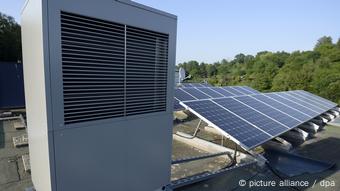
The heat pump takes heat from the environment and uses the principle of evaporative cooling for heating. Everyone, when sweating or applying a wet cloth to a warm body, knows this effect: when the moisture evaporates, that is, it changes to a gaseous state, the skin becomes cooler. Physical principle: When changing from water to steam, water molecules require a lot of energy. They take it from the environment – in this case, from the skin. On the other hand, when passing from vapor to liquid, thermal energy is released again.
This principle is used by heat pumps, refrigerators and air conditioners. Special refrigerant circulates in a closed piping system. These refrigerants evaporate at very low temperatures, sometimes below minus 50 degrees Celsius.
The refrigerant takes heat from the environment, such as the ground or air, and evaporates within the circuit. The gas mixture is then compressed in a compressor. This further raises the temperature in the coolant. The coolant then liquefies again, giving off heat to the heating water, which is used to heat the building.
Heat pumps – water, air or soil. Which are preferable?
There are different types of heat pumps, but they all work on the same principle and extract heat energy from water, land or air.
For example, water source heat pumps can use groundwater or water in rivers or lakes. Air source heat pumps operate with normal outside air or can use hot exhaust air from industrial plants or computer data centers.
The project to rebuild old houses in Berlin includes the construction of a heat pump and solar panels
For geothermal heat pumps, wells are drilled to a depth of 150 meters or pipes are placed directly below the surface of the earth, but below freezing level. The deeper the tube goes into the ground, the hotter it becomes. Geothermal heat pumps, both vertical and horizontal, are more efficient, but also more expensive. Air source heat pumps work almost everywhere, but they can be noisy.
By the way, when a heat pump works in groundwater, it cools down by about four degrees; when using an air source heat pump, the ambient temperature is reduced by about 10 degrees.
Can heat pumps heat up even in cold winters?
Yes, even on cold winter days, heat from the ground, ambient air or groundwater is enough to heat a building. In Scandinavia, for example, many homes are heated by air source heat pumps, even in winter. They even extract heat energy from the air at temperatures down to -20 degrees. However, in this case, heat pumps are not as efficient as at higher temperatures and require more electricity. To ensure safety, the heat pumps are also equipped with electric heaters that work at any temperature.
How much electricity do heat pumps need?
Although most of the energy is taken from the environment, heat pumps require additional electricity to run the compressor motor, pumps and fans. Under good conditions, up to six kilowatt-hours of heat can be generated from one kilowatt-hour of electricity received from outside. An 80 square meter detached apartment requires less than 1,000 kilowatt-hours of electricity per year.
In fact, according to a study by the Fraunhofer Institute for Solar Energy Systems (Fraunhofer ISE), air source heat pumps in old houses in Germany produce about three kilowatt-hours of heat from one kilowatt-hour of electricity. When using groundwater as a source, on average four times as much heat is generated.

Heat pump specialist Werner Schenk
Well-insulated buildings with underfloor heating or large radiators are ideal. In this case, the temperature of the heated water can even drop below 30 degrees Celsius. “Each degree of water temperature drop in the heating system increases the efficiency of the heat pump by 3.5%,” Werner Schenk, a heat pump specialist at the University of Applied Sciences Munich, told DW.
In principle, commercially available heat pumps can generate heating temperatures in excess of 70 degrees and thus heat uninsulated homes with old radiators. But the energy consumption for the operation of the device in this case will be much higher.
Should you use solar energy for a heat pump?
Yes, solar power from rooftop batteries is much cheaper than grid power and is also climate friendly. However, solar modules during the heating season in winter produce much less electricity than in summer. Then more solar modules are needed to produce the same amount of electricity – or you will have to get additional electricity from the power grid.

Efficient combination – heat pump and solar panels
Can a heat pump cool?
Yup. Modern heat pumps can switch to the opposite mode and cool down. In this case, the thermal energy of the buildings is transferred, for example, to the air or groundwater. On the other hand, modern air conditioning systems can also heat up.
Particularly efficient cooling can be achieved using groundwater and geothermal energy without a compressor. When using 1 kWh of electricity, up to 100 kWh of heat is absorbed and removed from underground.
Are sodas bad for the weather?
Most of them. Until now, heat pumps and air conditioners have mainly used chemical-derived refrigerants, which are 4,000 times more harmful to the climate than CO2. Fluorinated gases (so-called F gases) enter the atmosphere through leaks and improper disposal. That’s why more and more heat pumps are being sold with less environmentally hazardous refrigerants – propane, CO2 or ammonia. The EU also stipulates that in the coming years, environmentally friendly refrigerants should be increasingly used in heat pumps and air conditioning systems.
Source: DW
James Springer is a renowned author and opinion writer, known for his bold and thought-provoking articles on a wide range of topics. He currently works as a writer at 247 news reel, where he uses his unique voice and sharp wit to offer fresh perspectives on current events. His articles are widely read and shared and has earned him a reputation as a talented and insightful writer.